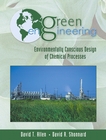|
||
| Green Engineering Textbook | Modules from Regional Workshops | |||
|
|||
| The goal of EPA's Chemical Engineering
Branch (CEB) is to introduce a "green" philosophy into
chemical engineering programs through the development of environmental
information disseminated to the academic and industrial communities.
This effort comes at a time when many universities are strengthening
their engineering education programs to include protection of the
environment. The first step in the achievement of this goal has been
the development of a Green Engineering textbook, Green
Engineering: Environmentally Conscious Design of Chemical Processes,
as well as a class outline.
In developing this textbook, EPA has responded to a need, which has been and continues to be expressed by academia; the need for a standardized course and text on green engineering, which emphasizes pollution prevention and incorporates risk as key principles. Current textbooks and courses on pollution prevention in chemical engineering emphasize waste minimization and do not incorporate an environmental risk assessment component. The Green Engineering textbook, on the other hand, emphasizes risk as a key principle. CEB’s expertise in risk assessment is a valuable resource for development of Green Engineering: Environmentally Conscious Design of Chemical Processes, a text for chemical engineering. The CEB’s textbook and class outline has been designed in a modular format - allowing universities to incorporate the entire course as a technical elective, or incorporate chapters of the course into current chemical engineering curricula. This material is disseminated to chemical engineering professors through American Society of Engineering Education's (ASEE) Chemical Engineering Division via a series of "Educate the Educator" sessions. Visit the Workshops page for additional information. Interest in green engineering curriculum goes far beyond the chemical engineering field. In addition to academia, Green Engineering curriculum material will be provided to AIChE for development of workshops and other training materials targeted for new and practicing engineers. Future projects will include tailoring the chemical engineering curriculum to other engineering and science fields. A solutions guide to the homework problems is available for instructors
using the textbook in their classrooms. |
|||
| |||
|
|||
|
|||
| Following are the modules in PowerPoint format utilized at the workshops.
Additional comments are imbedded in the notes field of the modules.
Module
1 (PowerPoint, 650 KB). Environmental Literacy: Environmental
Issues, Risk Exposure, and Regulations Module content included the following: Part I: An evaluation of the basic chemistry commonly used, introduction to risk of process (Chapter 2), assessment of chemical hazard (Chapter 5), worker exposure (Chapter 6), evaluation of alternative synthetic pathways (Chapter 7), and toxicity analysis - including bioaccumulation and persistence (Chapter 8). Part II: The establishment of a conceptual flowsheet and its potential emissions (Chapter 8), identification of waste streams, and process modifications (Chapter 9). Part III: An examination of process integration (heat exchange/mass exchange), primarily concentrating on water integration and incorporating pinch technology (Chapter 10 and Chapter 11). Two chemical reactions were utilized to illustrate these concepts: adipic acid from cyclohexane and the production of maleic anhydride. |
|||
![[logo] US EPA](https://webarchive.library.unt.edu/eot2008/20090508063434im_/http://www.epa.gov/epafiles/images/logo_epaseal.gif)

